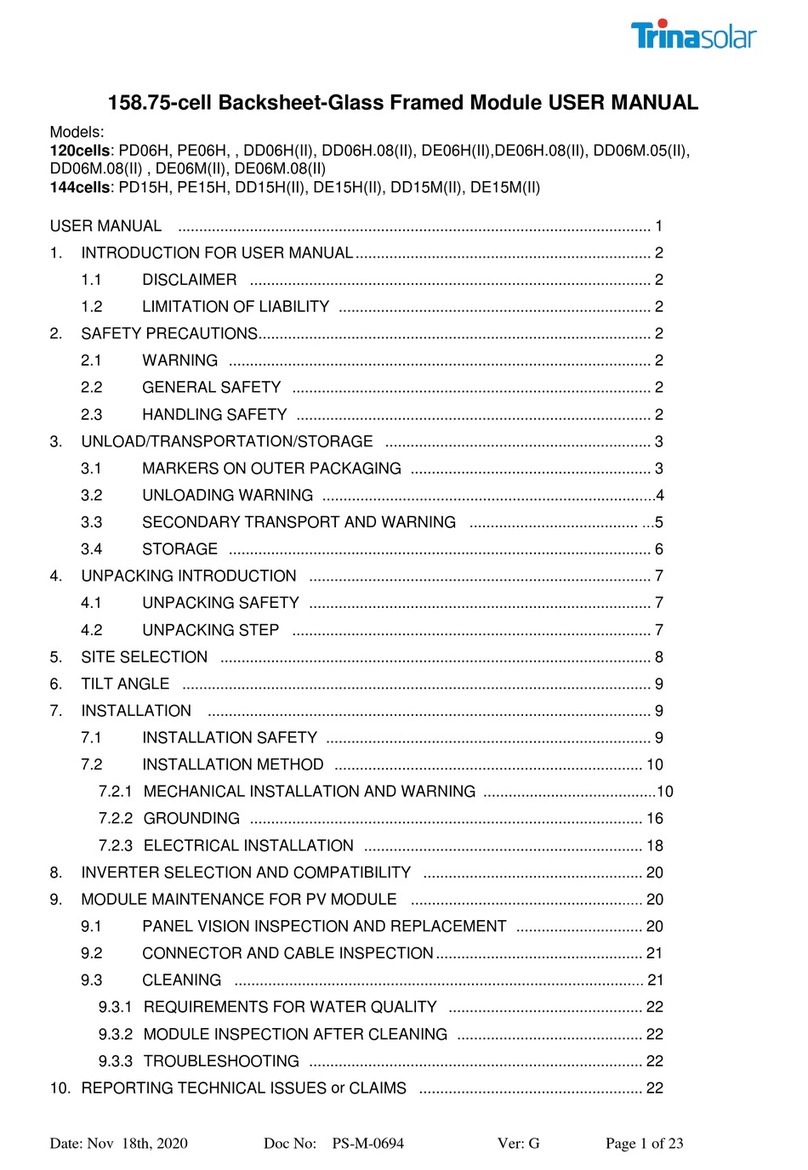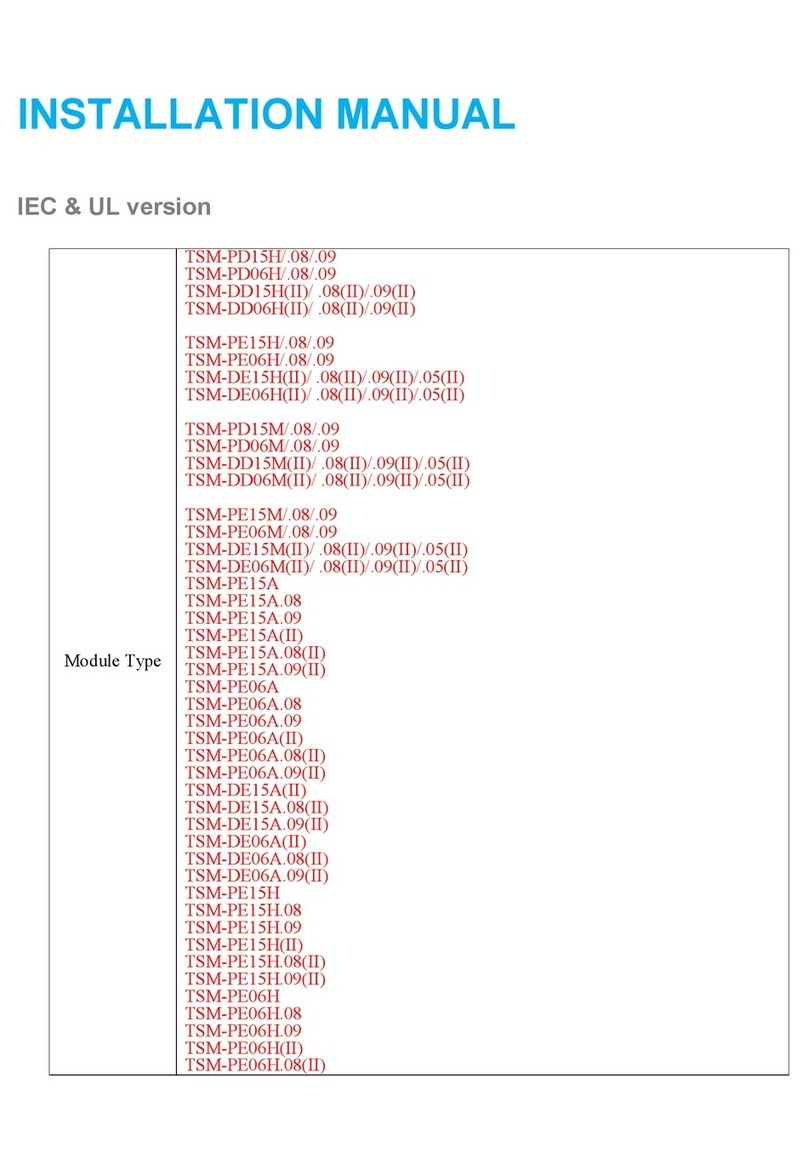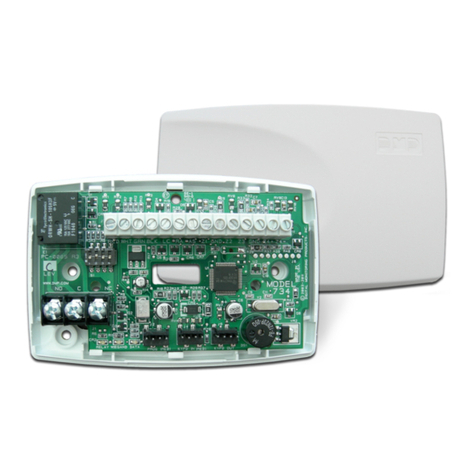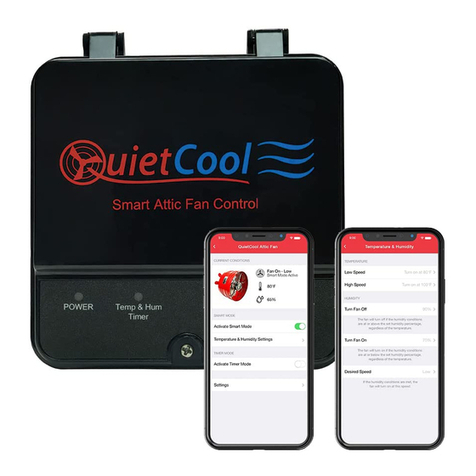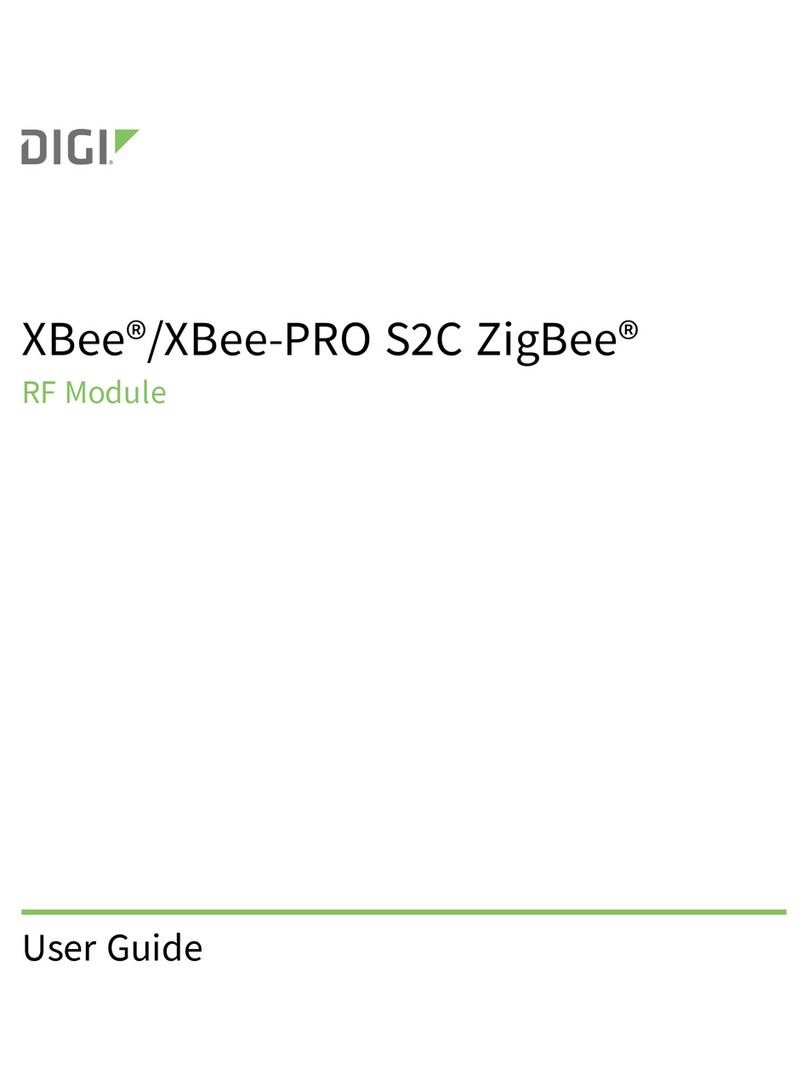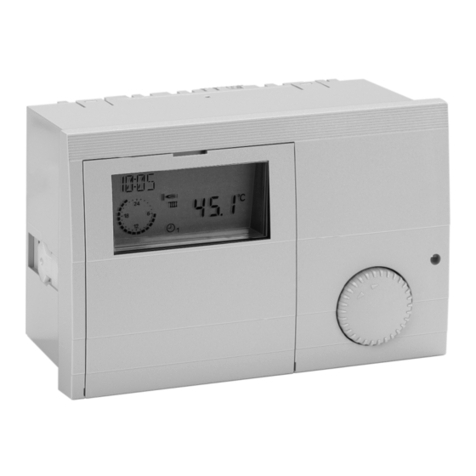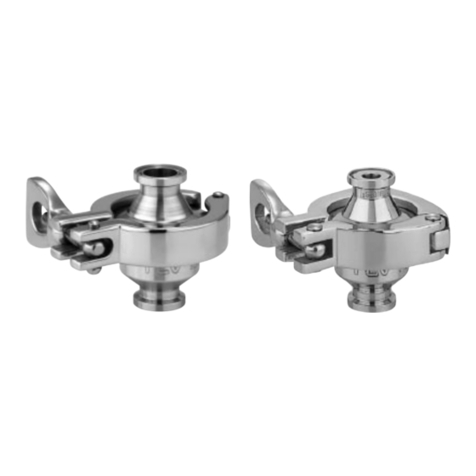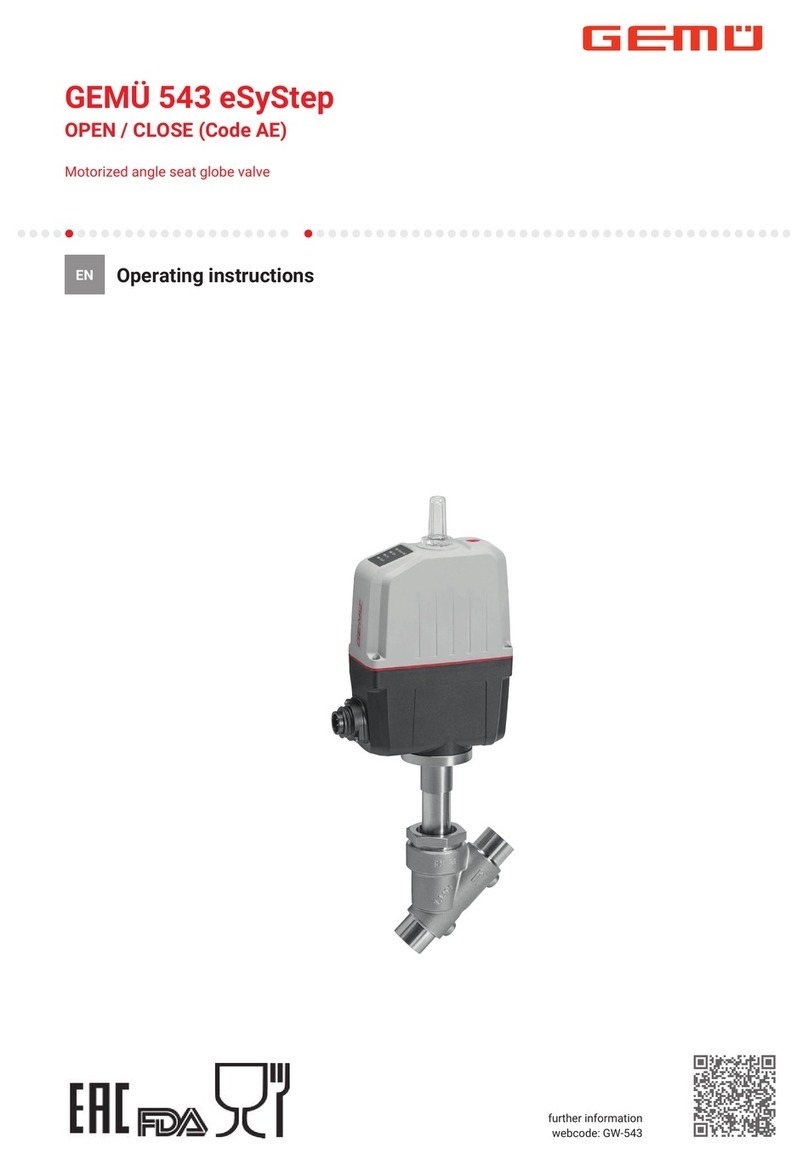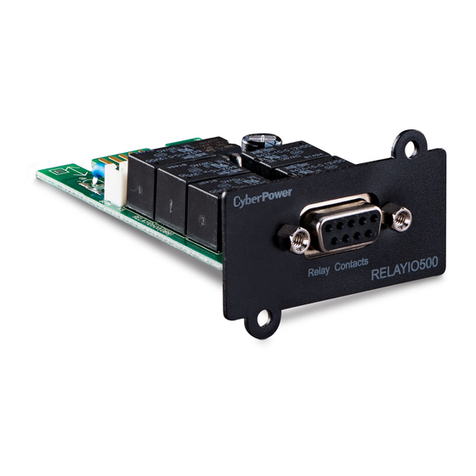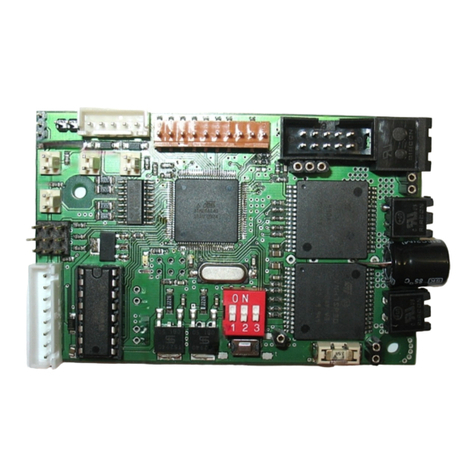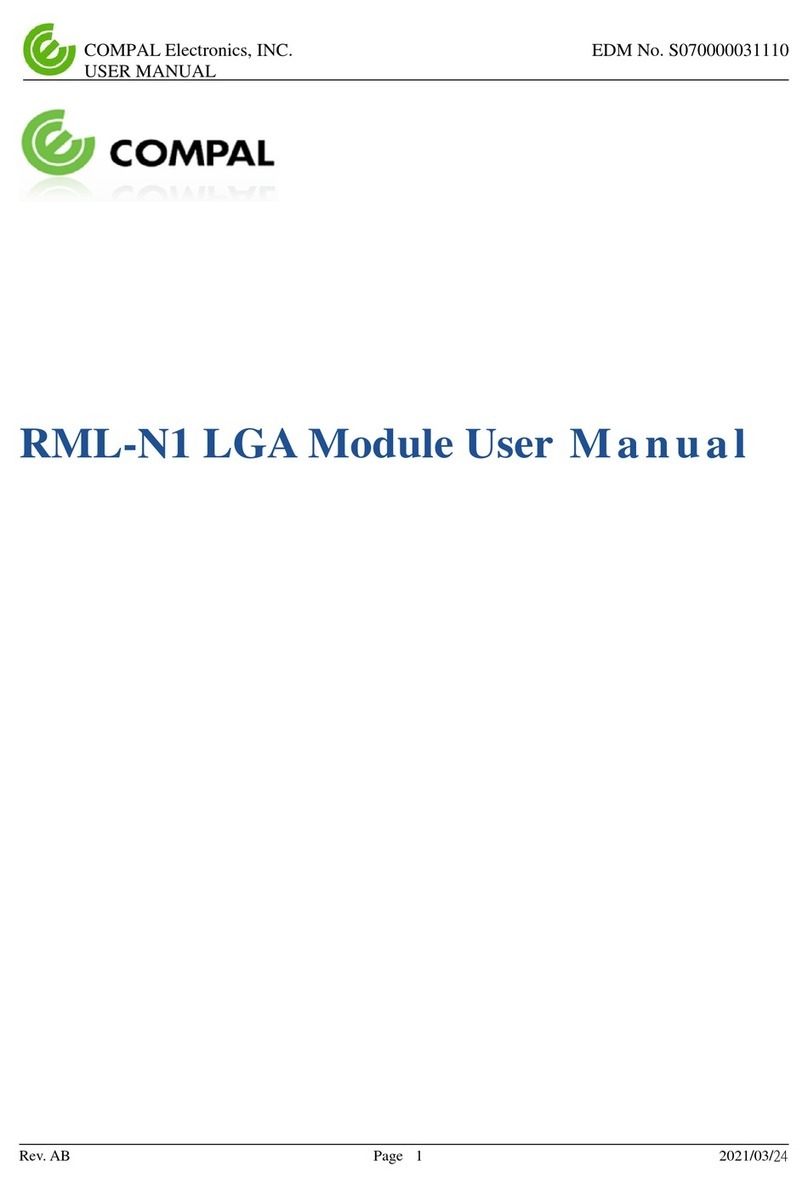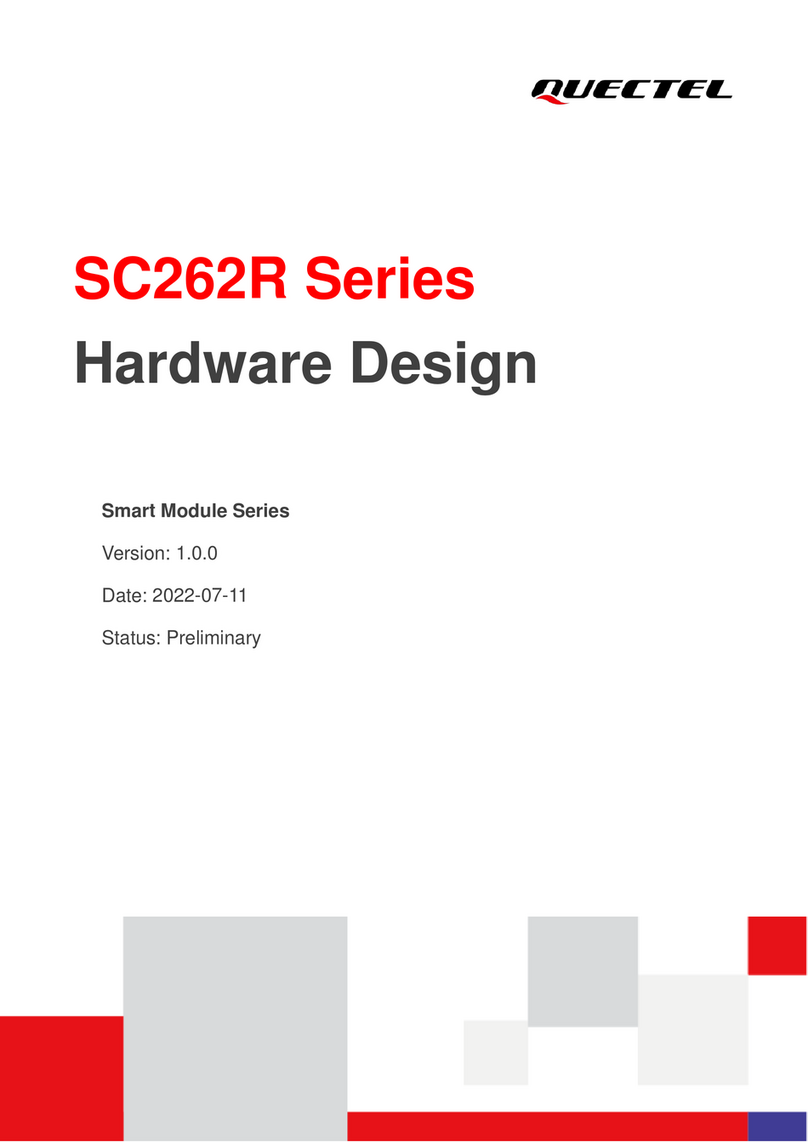Trina Solar TSM-PC05A TSM-PC05A.05 TSM-PC05A.08 User manual

INSTALLATION MANUAL
IEC & UL version
The Honey/Allmax Module
TSM-PC05A
TSM-PC05A.05
TSM-PC05A.08
TSM-PD05
TSM-PD05.05
TSM-PD05.08
TSM-PE05A
TSM-PE05A.08
The
Honey Plus Module
TSM-PC05A(II)
TSM-PC05A.08(II)
The
Tallmax Module
TSM-PC14
TSM-PD14
TSM-PE14A
The
Honey M Module
TSM-DC05A
TSM-DC05A.05
TSM-DC05A.08
The Honey/Allmax M Plus Module
TSM-DC05A(II)
TSM-DC05A.05(II)
TSM-DC05A.08(II)
TSM-DD05A(II)
TSM-DD05A.05(II)
TSM-DD05A.08(II)
TSM-DE05A(II)
The Tallmax M Plus Module
TSM-DD14A(II)
TSM-DE14A(II)
The
Trinasmart Module
TSM-PD05.052
TSM-PD05.082
TSM-PD14.002
TSM-DD05A.052(II)
TSM-DD05A.082(II)
The
Trinaswitch Module
TSM-PD05.08S
TSM-DD05A.08S(II)
TSM-DD05A.05S(II)
The
Trinapeak Module
TSM-PD05.08D
The
Splitmax Module
TSM-DC06.08(II)
TSM-PE05H
TSM-DE05H
TSM-PE14H(II)
TSM-DE14H(II)
The
Quadmax Module
TSM-DC80.08
The
Airmax Module
TSM-PC05B
The
Spacemax Module
TSM-DC03A.08(II)

Date: 2018.7.16
Doc No: PS-M-0434
Ver. D
Page - 2 - of 17
Table of Contents
1. DISCLAIMER OF LIABILITY .............................................................................................................. -3 -
2. SAFETY PRECAUTIONS ................................................................................................................... -3 -
3. UNPACKING AND STORAGE ........................................................................................................... -5 -
4. PRODUCT IDENTIFICATION ............................................................................................................. -6 -
5. ENVIRONMENTAL CONSIDERATIONS AND SITE SELECTION ...................................................... - 6 -
5.1 CLIMATE CONDITIONS ......................................................................................................... -6 -
5.2 SITE SELECTION ................................................................................................................... -6 -
6. MOUNTING INSTRUCTIONS ............................................................................................................. -7 -
6.1 MOUNTING METHODS .......................................................................................................... -7 -
A. Mounting with Bolts .............................................................................................................. -7 -
B. Mounting with Clamps .......................................................................................................... - 8 -
C. Mounting with Single-axis Tracking System...................................................................... - 10 -
6.2 GROUNDING ........................................................................................................................ -11 -
6.3 MODULE WIRING................................................................................................................. -13 -
7. ELECTRICAL CONFIGURATION..................................................................................................... -14 -
7.1 FUSING................................................................................................................................. -14 -
7.2 INVERTER SELETION AND COMPATIBILITY ..................................................................... - 14 -
8. MAINTENANCE AND CARE ............................................................................................................ -15 -
9. WARNING ........................................................................................................................................ -16 -

Date: 2018.7.16
Doc No: PS-M-0434
Ver. D
Page - 3 - of 17
•The installation, handling and use of Trina Solar crystalline modules are beyond company control. Trina
Solar does not assume any responsibility for loss, damage, injury or expense resulting from the improper
installation, handling, use or maintenance.
•Trina Solar assumes no responsibility for any infringement of patents or other rights of third parties that may
result from use of the module. No license is granted by implication or under any patent or patent rights.
•Specifications included in this manual are subject to change without prior notice.
•Potentially lethal DC voltages can be generated whenever PV Modules are exposed to a light source,
therefore, avoid contact with electrically active parts and be sure to isolate live circuits before attempting to
make or break any connections.
•Only authorized and trained personnel should have access or perform work on the modules or solar system,
always wearing rubber gloves and boots with maximum working voltage not lower than 1000V DC (For
TSM-PE05A.**, PE14A.**, not lower than 1500V DC).
•When working on electrical connections, remove all metallic jewelry, use properly insulated tools and wear
appropriate personal protective equipment to reduce the risk of electric shock.
•Do NOT stand or step on, damage or scratch the front or backside surfaces of the module.
•Broken modules cannot be repaired and contact with any module surface or frame can lead to electrical
shock. Do NOT use a module with broken glass or torn substrate.
•Do NOT disassemble the modules or remove any part of the module.
•Protect the electrical plug contacts against corrosion and soiling. Make sure that all connectors are
corrosion free and clean before making the connection.
•Do NOT install or handle modules when they are wet or during periods of high wind.
•Ensure that all connections are securely made with no gap between the contacts. Any gap can result in
electrical arcing that can cause a fire hazard and/or an electric shock.
•Make sure that the polarity of each module or a string is not reversed considering the rest of the modules
or strings.
•Do NOT artificially concentrate sunlight on these solar modules.
•Trina Solar modules are certified for operating in Application Class A installations at voltages below1000V
DC (For TSM-PE05A.**, PE14A.**, below 1500V DC). This maximum voltage should not be exceeded at
any time and, as the voltage of the module increases, above data sheet values, at operating temperatures
below 25°C, then these need to be taken into account when designing a PV system.
•Maximum system voltage must not exceed 1000V DC when UL 1000V products (TSM-****D*. **) are used.
•Maximum system voltage must not exceed 1500V DC when UL 1500V products (TSM-****E*. **) are used.
•Do NOT use water to extinguish fires of an electrical origin.
•Do NOT walk on the modules.
•Do NOT disconnect the modules under load to avoid arcs and electrical shocks. If needed cover the module
surface with an opaque cover.
•For modules under IEC investigation, under normal conditions, a solar photovoltaic module is likely to
experience conditions that produce more current and/or voltage than reported at standard test conditions.
Accordingly, the values of Isc and Voc marked on this module should be multiplied by a factor of 1.25 when
determining component voltage ratings, conductor current ratings, fuse sizes and size of controls connected
to the PV output.
•For modules under UL investigation, most of the time, the solar module is likely to produce more power, or
current, than that rated at standard test conditions. Accordingly, the value of ISC marked on this module
should be multiplied by a factor of 1.25 when determining the conductor current ratings, fuse sizes and size
of controls connected to the PV output. Refer to Section 690.8 of the National Electric Code to check when
an additional multiplying factor of 1.25 may be applicable.
•Installation in Canada shall be in accordance with CSA C22.1, Safety Standard for Electrical Installations,
and Canadian Electrical Code Part 1.The System Fire Class Rating of the module or panel in a mounting
system in combination with a roof covering complete with requirements to achieve the specified System
Fire Class Rating for a non-BIPV module or panel.
•Any module or panel mounting system has limitations on specific inclination required to maintain a specific
System Fire Class Rating.
1. DISCLAIMER OF LIABILITY
2. SAFETY PRECAUTIONS

Date: 2018.7.16
Doc No: PS-M-0434
Ver. D
Page - 4 - of 17
•Where common grounding hardware (nuts, bolts, star washers, spilt-ring lock washers, flat washers and the
like) is used to attach a listed grounding/bonding device, the attachment must be made in conformance with
the grounding device manufacturer's instructions.
•Common hardware items such as nuts, bolts, star washers, lock washers and the like have not been
evaluated for electrical conductivity or for use as grounding devices and should be used only for maintaining
mechanical connections and holding electrical grounding devices in the proper position for electrical
conductivity. Such devices, where supplied with the module and evaluated through the requirements in
UL1703, may be used for grounding connections in accordance with the instructions provided with the
module.
•Rated electrical characteristics are within ± 10 percent of measured values at Standard Test Conditions of
1000 W/m², 25°C cell temperature and AM 1.5 solar spectral irradiance.
•The fire rating of a Trina Solar PV module is valid only when mounted in the manner specified in the
mechanical mounting instructions of this installation manual.
•The module is considered to be in compliance with UL1703 only when the module is mounted in the manner
specified by the mounting instructions below.
•A module with exposed conductive parts is considered to be in compliance with UL1703 only when it is
electrically grounded in accordance with the instructions presented below and the requirements of the
National Electrical Code for UL listed products only.
•Any module without a frame (laminate) shall not be considered in compliance with the requirements of
UL1703 unless the module is mounted with hardware that has been tested and evaluated with the module
under this standard or via a field inspection certifying that the installed module complies with the
requirements of UL1703.
•Modules equipped with PV wiring connectors that comply with the Standard for Connectors for Use in
Photovoltaic Systems, UL 6703, shall have the specific allowable mating connector manufacturer(s) and
model number(s) listed, as well as contact information and/or website of the PV connector manufacturer. If
a specific module product is available with multiple PV wiring connectors from various manufacturers, then
the following shall be included: 1) Means to identify each distinct PV connector manufacturer's product -
such as a picture or illustration, unique physical features, markings, company logos, etc, and 2) Allowable
mating connector manufacturer and model number(s) listed for each distinct cable connector
manufacturer's product(s), as well as contact information and/or website of the PV connector manufacturer.
The Type 1 and/or Type 2 modules with the specified constructions in the table below, when installed with
a UL listed mounting system that has been rated as a Class A System, is suitable to maintain the System
Class A Fire Rating.
Module model
Specific construction
Marking
TSM-xxxPD05
TSM-xxxPD05.05
TSM-xxxPD05.08
Please check the related UL description files when
checking the fire protection rank of the BOM
concerned
Module Fire Performance:
Type 1/ Type 2
TSM-xxxPE05A
TSM-xxxPE05A.08
Please check the related UL description files when
checking the fire protection rank of the BOM
concerned
Module Fire Performance:
Type 1/ Type 2
TSM-xxxDD05A(II)
TSM-xxxDD05A.05(II)
TSM-xxxDD05A.08(II)
Please check the related UL description files when
checking the fire protection rank of the BOM
concerned
Module Fire Performance:
Type 1/ Type 2
TSM-xxxPD05.08D
Please check the related UL description files when
checking the fire protection rank of the BOM
concerned
Module Fire Performance:
Type 1/ Type 2
•The Type 1 and/or Type 2 modules with the specified constructions in the table below, when installed with
a UL listed mounting system that has been rated as a Class A System, is suitable to maintain the System
Class A Fire Rating.
Module model
Specific construction
Marking
TSM-xxxPD14
TSM-xxxPE14
TSM-xxxDE14
Please check the related UL description files when
checking the fire protection rank of the BOM
concerned
Module Fire Performance:
Type 1/ Type 2
TSM-xxxPE14A
TSM-xxxDE14A
Please check the related UL description files when
checking the fire protection rank of the BOM
converned
Module Fire Performance:
Type 1/ Type 2

Date: 2018.7.16
Doc No: PS-M-0434
Ver. D
Page - 5 - of 17
TSM-xxxDD14A(II)
TSM-xxxPE14H(II)
TSM-xxxDE14H(II)
Please check the related UL description files when
checking the fire protection rank of the BOM
concerned
Module Fire Performance:
Type 1/ Type 2

Date: 2018.7.16
Doc No: PS-M-0434
Ver. D
Page - 6 - of 17
•For cUL listed products only: Fire class rating: C
•The fire rating of the module is valid only when mounted in the manner specified in the mechanical mounting
instructions.
•The module is considered to be in compliance with UL1703 only when the module is mounted in the manner
specified by the mounting instructions.
•A module with exposed conductive parts is considered to be in compliance with UL1703 only when it is
electrically grounded in accordance with the instructions and the requirements of the National Electrical
Code.
•Any module without a frame (laminate) shall not be considered to comply with the requirements of UL1703
unless the module is mounted with hardware that has been tested and evaluated with the module under
this standard or by a field Inspection certifying that the installed module complies with the requirements of
UL1703.
•Modules equipped with PV wiring connectors that comply with the Standard for Connectors for Use in
Photovoltaic Systems, UL 6703, shall have the specific allowable mating connector manufacturer(s) and
model number(s) listed as below:
Female type
Allowable male
type to mate
Connector
manufacturer
Contact
information
and/or website
of the PV
connector
manufacturer
Trade mark
identification
Rated Voltage
PVMC4PLS-XX
PVMC4PLS-XX
Staubli
Electrical
Connectors AG
http://ec.staubli.
com/
MC
1000V or 1500V
PV-KBT4
PV-KST4
Staubli
Electrical
Connectors AG
http://ec.staubli.
com/
MC
1000V
PV-KBT4-EVO2
PV-KST4-EVO2
Staubli
Electrical
Connectors AG
http://ec.staubli.
com/
MC
1000V or 1500V
QC4.10-ab
QC4.10-ab
QC Solar
(Suzhou) Corp
http://www.quic
k-contact.com/
QC
1000V
QC4.10-cd
QC4.10-cd
QC Solar
(Suzhou) Corp
http://www.quic
k-contact.com/
QC
1000V or 1500V
Helios H4
Assembled
Helios H4
Assembled
Amphenol
Industrial
Operations
http://www.amp
henol-industrial
.com
AMPHENOL
1000V
UTXCFd4Ag
(“d”=A or B;
“g”=I, C or M)
UTXCMd4Ag
(“d”=A or B;
“g”=I, C or M)
Amphenol
Technology
(Shenzhen) Co
Ltd
http://www.amp
henol-industrial
.com
UTX
1000V or 1500V
TS4
TS4
Changzhou Trin
a Solar Energy
Co., Ltd
www.trinasolar.
com
TS4
1000V or 1500V
•At time of receipt, verify that the product delivered is in fact the product ordered. The product name,
subname, and serial number of each laminate are clearly marked on the outside of each packing box.
•Leave the product in its original packing box until you are ready to install.
•Store packing boxes in a clean, dry area with relative humidity below 85% and storage temperatures
between -20°C and 50°C.
•Do NOT stack more than the maximum amount of allowable pallets on top of each other.
•At the installation site, take care to keep modules and particular their electrical contacts clean and dry before
installation. If connector cables are left in damp conditions then the contacts may corrode. Any module with
corroded contacts should not be used.
3. UNPACKING AND STORAGE

Date: 2018.7.16
Doc No: PS-M-0434
Ver. D
Page - 7 - of 17
•If pallets are stored temporarily outside then place a protective covering over the pallet to protect it from
direct weathering and do not stack more than 1 pallet high.
•Two people are required to unpack the modules from the packing box, when handling modules always use
both hands.
•Protect the module edges for temporary storage outside the pallet.
•Do NOT use a knife to cut the zip-ties, but use wire cutting pliers.
•Do NOT place modules directly on top of each other.
Each individual module has a unique serial number laminated behind the glass and another permanently
attached to the back-sheet of the module on the product sticker. Note all serial numbers in an installation for
your future records.
5.1 CLIMATE CONDITIONS
Trina Solar Crystalline series modules may be installed in the following conditions for more than 25 years. In
addition to the required IEC certification, Trina Solar products have also been tested to verify resistance to
ammonia fumes that may be present around barns sheltering cattle, as well as suitability for installation in humid
(coastal) areas and areas of high sand storms.
Environment
•Operating temperature: -40°C to +85°C
•Storage temperature: -20°C to +50°C
•Humidity: below 85RH%
•Mechanical Load Pressure*: 5400Pa Max from the front side (snow) and 2400Pa from the rear (wind).
(Except Installation Method C: Mounting with Single-axis Tracking System - 2400Pa (snow) and 2400Pa
(wind) max under UL1703 standard)
*NOTE:
•When the project environment meet above temperature, but over 85RH%. Please contact local technical
support and provide project climate information.
•The modules have been evaluated by TUV according to IEC61215 for a maximum positive or negative
design loading of below 5400Pa, by UL according to UL 1703, below 30lbs.ft2.
•The mechanical load bearing is dependent upon the mounting methods used and failure to follow the
instructions of this manual may result in different capabilities to withstand snow and wind loads.
•The system installer must ensure that the installation methods used meet these requirements and any
local codes and regulations.
5.2 SITE SELECTION
•Trina Solar Modules can be mounted in landscape or portrait orientation however the impact of dirt
shading the solar cells can be minimized by orienting the product in landscape.
•Solar module is recommended to be installed at an optimized tilt angle to maximize the energy output. It is
roughly equal to the latitude of the project site as a rule of thumb, facing to equator. But always to design
based on local situations to find out the optimum one.
•When installing solar modules on a roof always leave a safe working area between the edge of the roof
and the external edge of the solar array.
•In case of residential installations on the ground, modules shall be installed following local regulations, e.g.
using fence.
•Position the modules to minimize the chances of shading at any time of the day.
•Do not install PV modules in a location where they will be immersed in water or continually exposed to
water from a sprinkler or fountain, etc.
•Avoid using a mounting method that will block the drainage holes in the module frame.
•When all solar modules (except for smart module) are mounted in the same plane and orientation then all
can be expected to have similar performance throughout the day and can be connected together to the
4. PRODUCT IDENTIFICATION
5. ENVIRONMENTAL CONSIDERATIONS AND SITE SELECTION

Date: 2018.7.16
Doc No: PS-M-0434
Ver. D
Page - 8 - of 17
same inverter channel.
•If solar modules (except for smart module) on the same installation are mounted at different angles or
orientations then energy production can normally be optimized by connecting the different orientations to
different inverters (or different MPPT if the inverter has more than one MPPT). Refer to inverter
manufacturers for further guidelines.
•According to Intertek-conducted IEC 61701:2011, salt mist corrosion testing of photovoltaic (PV), Trina
Solar modules can be safely installed in corrosive salt areas within proximity of the ocean or sulfurous areas.
•According to IEC62716:2013 “Ammonia corrosion testing of photovoltaic (PV) modules” and DLG Fokus
testing for ammonia resistance, Trina Solar modules can be safely installed in ammonia-heavy
environments, such as farm houses.
6.1 MOUNTING METHODS
PV modules can be mounted to the substructure using either corrosion-proof M8 bolts placed through the
mounting holes on the rear of the module or specially designed module clamps.
Regardless of the fixing method the final installation of the modules must ensure that:
•A clearance of at least 115mm(4.5in) (recommended) is provided between modules frame and the surface
of the wall or roof. If other mounting means are employed this may affect the UL Listing or the fire class
ratings.
•The minimum distance between two modules is 10mm(0.4in).
•The mounting method does not block the module drainage holes.
•Panels are not subjected to wind or snow loads exceeding the maximum permissible loads, and are not
subject to excessive forces due to the thermal expansion of the support structures.
*NOTE: The drain holes cannot be blocked in any situation during installation or use.
A. Mounting with Bolts
•The frame of each module has 4-φ9*14mm mounting holes, ideally placed to optimize the load
handling capability, to secure the modules to supporting structure.
•To maximize mounting longevity, Trina Solar strongly recommends the use of corrosion proof
(stainless steel) fixings
•Secure the module in each fixing location with an M8 bolt and a flat washer, spring washer and nut as
shown in Figure 1 and tighten to a torque of 16~20 N.m(140-180lbf.in.).
•All parts in contact with the frame should use flat stainless steel washers of minimum 1.8mm thickness
with an outer diameter of 20-24mm(0.79-0.94in).
Dimension of DC06.08 (II)
6. MOUNTING INSTRUCTIONS

Date: 2018.7.16
Doc No: PS-M-0434
Ver. D
Page - 9 - of 17
Figure 1. PV module installed with Bolt fitting method
1) Installing Hole (Φ9x12 will be replaced step by step by Φ9x14 from Aug 2017 to Q2 2018)
2) Aluminum Frame 3) M8 Stainless Bolt
4) Flat Stainless Washer 5) Spring Stainless Washer
6) HEX Stainless Nut
B. Mounting with Clamps
•Trina Solar has tested its modules with a number of clamps from different manufacturers and
recommends the use of clamps which have an EPDM or similar insulating washer, fixing bolt of at least
M6.
•The clamp must overlap the module frame by at least 7mm (0.28in) but no more than 10mm (0.39in).
•Use at minimum 4 clamps to fix modules on the mounting rails.
DRAIN HOLE
1

Date: 2018.7.16
Doc No: PS-M-0434
Ver. D
Page - 10 - of 17
•Modules clamps should not come into contact with the front glass and must not deform the frame.
•Be sure to avoid shadowing effects from the module clamps.
•The module frame is not to be modified under any circumstances.
•When choosing this type of clamp-mounting method, use at least four clamps on each module, two
clamps should be attached on each long sides of the module (for portrait orientation) or each short
sides of the module (for landscape orientation). Depending on local wind and snow loads, additional
clamps may be required to ensure that modules can bear the load.
•Applied torque should refer to mechanical design standard according to the bolt customer is using, ex:
•M6 ---- 9 N.m (70lbf.in)
•M8 ---- 16-20N.m(140-180lbf.in)
End Clamp installation Middle Clamp installation
Figure 2. PV module installed with clamp fitting method
4-φ9*1412 installation hole
Mounting rail
+5400Pa/-2400Pa Load
±2400Pa Load
Mounting system

Date: 2018.7.16
Doc No: PS-M-0434
Ver. D
Page - 11 - of 17
Clamping system
Attachment to the long frame
This is Only for TSM-DC03A.08(II)
This is Only for TSM-PC05B
Clamping system
Attachment to the short
frame
Other mounting configurations can be used. However, failure to comply with the above recommendations will
result in a lowering of the load handling (snow/wind load) capabilities below the product specification
5400/2400Pa (IEC), 30 lbs.ft2 (UL1703) and product failure as a result of an overload situation will not be covered
by the Trina Solar warranty.
C. Mounting with Single-axis Tracking System
•This installation is only for 72 cells polycrystalline modules.
•It is a Single-axis Tracking System, the module is fixed on the axis by bolting longframe.
•The frame of each module has 4-φ7*10mm(0.28*0.39in) mounting holes with specific location shown
in Figure 3.
•Secure the module in each fixing location with an M6 bolt, two flat washers, a spring washer and nut
as shown in Figure 3.
•If a different bolt similar to M6 is used, they need to be tightened to a torque of 16N.m.(140lbf.in).
•All parts in contact with the frame should use flat stainless steel washers of minimum 1.5mm thickness
with an outer diameter of 16-20mm (0.63-0.79in.).
•The bolt should be made of stainless steel or the other anti-corrosion material.
•Mechanical Load Pressure under this method: 30 lbs.ft2 (snow) max from the front side & 30 lbs.ft2
(wind) max from the rear according to UL1703.

Date: 2018.7.16
Doc No: PS-M-0434
Ver. D
Page - 12 - of 17
6.2 GROUNDING
Figure 3. PV module installed with Single-axis Tracing System
1) M6 Stainless Bolt 2) Flat Stainless Washer
3) Spring Stainless Washer 4) HEX Stainless Nut
•All module frames and mounting racks must be properly grounded in accordance with appropriate
respective National Electrical Code.
•Proper grounding is achieved by bonding the module frame(s) and all metallic structural members
together continuously using a suitable grounding conductor. The grounding conductor or strap may be
copper, copper alloy, or any other material acceptable for use as an electrical conductor per respective
National Electrical Codes. The grounding conductor must then make a connection to earth using a
suitable earth ground electrode.
•Trina Solar modules can be installed with the use of third party listed grounding devices for grounding
the metallic frames of PV modules. The devices have to be installedin accordance with the grounding
device manufacturer’s specified instructions.
•Please refer to the “Product Catalogue” link for detailed grounding hole location and size at
400mm
(15.7in)
1
2
Φ7*10mm(0.28*0.39in)
INSTALLING HOLES
3
4

Date: 2018.7.16
Doc No: PS-M-0434
Ver. D
Page - 13 - of 17
•
•
•
•
•
•
•
•
•
www.trinasolar.com.
•We also recommend using the following methods to ground installation properly under UL
investigation,
Method 1: Tyco grounding bolt # 2058729-1:
Figure 4. Tyco grounding bolt # 2058729-1
1) Wire bolt and slot 2) Mounting wash hex nut
3) Aluminum frame 4) 0.006 to 0.025in2 cable
5) Hex Nut
•Tyco grounding hardware comes in a package that includes the grounding bolt, mounting and
grounding hex nut.
•Electrical contact is made by penetrating the anodized coating of the aluminum frame, and tightening
the mounting hex nut (come with the star washer) to the proper torque of 25lbf.in.
•Grounding wire size (6 to 12 AWG solid bare copper) should be selected and installed underneath the
wire binding bolt.
•The wire binding bolt should be tightened to the proper torque of 45lbf.in.
Method 2: Tyco grounding bolt #1954381-2:
2
1 3
4
5
Figure 5. Tyco grounding bolt # 1954381-2
(Not applicable for TRINAMOUNT module series)
1) Wire slot (available for 0.006 to 0.025in2 cable) 2) Slider
3) Bolt 4) Base
5) Nut
•Tyco grounding hardware comes in a package that includes the grounding bolt, mounting and
grounding hex nut.
•Electrical contact is made by penetrating the anodized coating of the aluminum frame, and tightening
the mounting hex nut (come with the star washer) to the proper torque of 25lbf.in.
1
2
3
4
5

Date: 2018.7.16
Doc No: PS-M-0434
Ver. D
Page - 14 - of 17
•Grounding wire size (6 to 12 AWG solid bare copper) should be selected and installed underneath the
wire binding bolt.
•The wire binding bolt should be tightened to the proper torque of 45lbf.in.
•The Tyco grounding bolt is only listed for use with 6 to 12 AWG bare solid copper wire.
Method 3: ERICO grounding bolt # EL6CS14-6
Figure 6. ERICO grounding bolt # EL6CS14-6
(Not applicable for the TRINAMOUNT module series)
1) Machine Bolt A 2) Machine Bolt B
3) Belleville washer 4) Flat Washer
5) Clearance hole for #10[M5] machine bolt 6) Aluminum frame
7) Machine box hex nut with lock washer 8) Grounding bolt
•The lug should be installed on a surface that is larger than the bottom surface of the lug.
•The lug should be installed in the grounding holes provided on the PV module.
•Machine bolt A should be torqued to 35lbf.in, to secure the grounding bolt to module frame.
•The grounding bolt is only listed for use with 6-12 AWG bare solid copper wire.
•For proper wire binding, machine bolt B should be torqued to 35lbf.in.
6.3 MODULE WIRING
•All wiring should be performed, by qualified installers, in accordance with the local codes and
regulations.
•Modules can be connected in series to increase the operating voltage by plugging the positive plug of
one module into the negative socket of the next. Before connecting modules always ensure that the
contacts are corrosion free, clean and dry.
•Product can be irreparably damaged if an array string is connected in reverse polarity to another.
Always verify the voltage and polarity of each individual string before making a parallel connection. If
you measure a reversed polarity or a difference of more than 10V between strings then check the string
configuration before making the connection.
•Trina Solar modules are provided with stranded copper cables with a cross sectional area of
4mm²(0.006in²) which are rated for 1000V DC, 90°C and are UV resistant.( For TSM-PE05A.**,
PE14A.**, 1500 V DC, 90°C and are UV resistant) All other cables used to connect the DC system
should have a similar (or better) specification. Trina Solar recommend that all cables are run in
appropriate conduits and sited away from areas prone to water collection.
•The maximum voltage of the system must be less than the maximum certified voltage 1000V typically
(For TSM-PE05A.**, PE14A.** , less than 1500V) and the maximum input voltage of the inverter and
of the other electrical devices installed in the system. To ensure that this is the case, the open circuit
voltage of the array string needs to be calculated at the lowest expected ambient temperature for the
location. This can be done using the following formula.
Max System voltage ≥ N * Voc * [1 + TCvoc x (Tmin-25)]
Where
N No modules in series
Voc Open circuit voltage of each module (refer to product label or data sheet)

Date: 2018.7.16
Doc No: PS-M-0434
Ver. D
Page - 15 - of 17
TCvoc Thermal coefficient of open circuit voltage for the module (refer to datasheet)
Tmin The lowest ambient temperature
•Each module have two standards 90°C sunlight resistant output cables each terminated with plug &
play connectors. The wire type and gauge of the output cables are 1000V (For TSM-PE05A.**,
PE14A.** which are 1500V DC) rated PV Wire cable and are 12AWG in size. This cable is suitable for
applications where wiring is exposed to the direct sunlight. We require that all wiring and electrical
connections comply with the appropriate National Electrical Code.
•The minimum and maximum outer diameters of the cable are 5 to 7mm(0.038 to 0.076in2).
•For field connections, use at least 4mm2 copper wires insulated for a minimum of 90°C and sunlight
resistance with insulation designated as PV Wire.
•The minimum bending radius cables should be 43mm(1.69in).
Photovoltaic (electric) systems operate automatically and require very little day-to-day supervision. The solar
array generates DC electricity whenever light falls on it similarly the inverter automatically turns ON as soon as
there is sufficient energy from the solar array to efficiently convert this into grid.
*Caution:
•The module is rated to operate at potentially lethal DC voltages which have the potential can cause severe
electrical shock, arcing and fire hazards. Whilst some solar modules, manufactured by Trina Solar, are
certified to operate up to 1000V DC (For TSM-PE05A.**,PE14A.**, to 1500V DC) always check the module
label to confirm the actual rating of your product before making connections.
•It is recommended to use a suitably rated isolator (DC switch) to interrupt the current flow before
disconnecting the connectors.
7.1 FUSING
•When fuses are fitted they should be rated for the maximum DC voltage and connected in each, non-
grounded pole of the array (i.e. if the system is not grounded then fuses should be connected in both the
positive and negative poles).
•The maximum rating of a fuse connected in series with an array string is typically 15A but the actual module
specific rating can be found on the product label and in the product datasheet.
•This fuse rating value also corresponds to the maximum reverse current that a module can withstand (when
one string is shaded then the other parallel strings of modules will be loaded by the shaded string and
current will flow) and therefore impacts the number of strings in parallel.
7.2 INVERTER SELETION AND COMPATIBILITY
•When installed in systems governed by IEC regulations, Trina Solar modules normally do not need to be
electronically connected to earth and therefore can be operated together with either galvanically isolated
(with transformer) and transformerless inverters.
•Potential Induced Degradation (PID) is sometimes observed in PV modules due to a combination of high
humidity, high temperature and high voltage. PID is most likely to cause degradation under the following
conditions:
a) Installations in the warm and humid climates
b) Installation close to a source of continual moisture, such as bodies of water
•To reduce the risk of PID, we strongly suggest that modules feature Trina Solar’s Anti-PID technology, which
can be applied to any Trina product. Alternatively, we recommend the use of an inverter that
Incorrect Routing of cable Correct Routing of cable
7. ELECTRICAL CONFIGURATION

Date: 2018.7.16
Doc No: PS-M-0434
Ver. D
Page - 16 - of 17
includes a transformer as well as proper grounding of the negative DC leg of the PV array.
•Choose inverters with isolation transformers in hot and wet areas (such as shores, wetlands), to ensure
proper module function under positive voltage.
•A well designed solar system requires minimal maintenance; however, system performance and reliability
can be improved by taking some simple steps.
•Maintenance should be carried out at least once a year by trained personnel, always wearing rubber gloves
and boots with maximum working voltage not lower than 1000V DC (For TSM-PE05A.**, PE14A.**, not
lower than 1500V DC).
•Trim any vegetation which may shade the solar array thus impacting performance.
•Check that mounting hardware is properly tightened.
•Inspect all cables to verify that connections are tight; the cables are protected from direct sunlight and sited
away from areas of water collection.
•Check that all string fuses in each non/earthed pole are operating.
•It is recommended to check the torque of terminal bolts and the general condition of wiring at least once a
year. Also, check that mounting hardware is properly torqued. Loose connections will result in damage to
the array.
•Replacement modules must be of same type. Do not touch live parts of cables and connectors. Use
appropriate safety equipment (insulated tools, insulating gloves, etc.) when handling modules.
•The amount of electricity generated by a solar module is proportional to the amount of light falling on it. A
module with shaded cells will produce less energy and therefore it is important to keep modules clean.
•Normally rain water is sufficient to keep the modules clean however it is particularly important to ensure that
the solar modules are clean before onset of summer. Products installed at a tilt angle below 10° or which
are located in particularly dusty areas, are installed in landscape orientation or in areas of high pollution or
close to large bird populations will require more regular cleaning.
•When cleaning the module use a soft cloth together with a mild detergent and clean water. Take care to
avoid severe thermal shocks which might damage the module by cleaning modules with water which has a
similar temperature to the modules being cleaned.
•When cleaning the back surface of the module, take care to avoid penetrating the substrate material.
Modules that are mounted flat (0° tilt angle) should be cleaned more often, as they will not “self-clean” as
effectively as modules mounted at a 10° tilt or greater.
•The benefit of cleaning dirt and debris from the array is a trade-off between the cost of the cleaning,
increased energy production as a result of this cleaning, and the inevitable re-soiling of the laminates over
time once they have been cleaned.
•In the event that the solar modules need to be cleaned then clean the module use a soft cloth together with
a mild detergent and clean water. Take care to avoid severe thermal shocks which might damage the
module by cleaning modules with water which has a similar temperature to the modules being cleaned.
•On large systems, the benefit of cleaning dirt and debris from the array is a trade-off between the cost of
the cleaning, increased energy production as a result of this cleaning, and the time for the re-soiling of the
modules after cleaning.
•If you are unsure whether the array or section thereof needs to be cleaned then first select an array string
that is particularly soiled then
Measure & record the inverter feed in current from that string
Clean all modules in the string
Measure the inverter feed in current again and calculate the % improvement from cleaning
If the improvement is less than 5% then it is normally nor worth spending the expense on cleaning
•The above verification should only be carried out when the insolation is effectively constant (clear sky,
strong sunshine, no clouds)
•The back surface of the module normally does not need to be cleaned but, in the event this is deemed
necessary, avoid the use of any sharp projects that might damage the penetrating the substrate material.
•Cover the front surface of modules by an opaque material when repairing. Modules when exposed to
sunlight generate high voltage and are dangerous.
•Trina Solar PV modules are equipped with bypass diodes in the junction box. This minimizes module
heating and current losses.
Do not try to open the junction box to change the diodes even if they malfunction.
In a system using a battery, blocking diodes are typically placed between the battery and the PV
8. MAINTENANCE AND CARE

Date: 2018.7.16
Doc No: PS-M-0434
Ver. D
Page - 17 - of 17
module output to prevent battery discharge at night.
•Product Replacement:
In the event that a module is damaged (broken glass or scratch on back sheet) and needs to be replaced
then
Observe the safety precautions listed earlier in the manual
Wear cut resistant gloves and other personal protective equipment required for the particular
installation.
Isolate the impacted array string to prevent current flow before attempting to remove the module.
Disconnect the connectors of the affected module using the related disconnect tool provided by
suppliers.
Replace the damaged module with a new module of the same type.
Check the open circuit voltage of the array string and verify that this is within 10V of the other strings to
be connected in parallel.
Turn the isolator back on.
•Troubleshooting:
If your installation does not work properly, please inform your installer immediately.
•Reporting Technical Issues or Claims:
Contact your installer
Contact Trina Solar after sales service team at http://customerservice.trinasolar.com/
Submit the Customer Feedback form at: http://www.trinasolar.com/ and one of our technical service
representatives will contact you within 5 business days. A username and password is required to send
feedback from the customer service link
For module specifications or datasheets, please download from: http://www.trinasolar.com/
WARNING: For any electrical maintenance, the PV system must first be shut down. Improper
maintenance can cause lethal electric shock and/or burns.
Edition Revision Date Revised Item Revised Content
New Edition 2016.05.05
2nd Edition 2017.02.20
1. Add unit of UL mechanical measuring
2. Add connector
1. Pa psf
2. Clarify detail connector.
3rd Edition
2017.05.27
Module size standardization
1.
Figure 1, add Installing hole
note
2. Figure 3, use
distance of
installing holes instead of
module size
4th Edition 2017.07.14 Add connector Add four types of connector
5th Edition 2018.07.16 Modules added Half-Cut Products (H)
9. WARNING
10. HISTORY
This manual suits for next models
55
Table of contents
Other Trina Solar Control Unit manuals
Popular Control Unit manuals by other brands
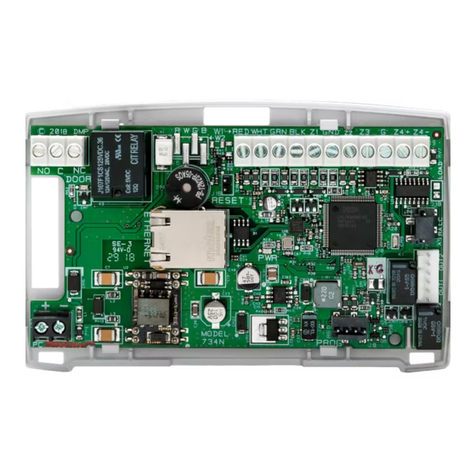
DMP Electronics
DMP Electronics 734N Series Installation and programming guide

Chemglass Life Sciences
Chemglass Life Sciences CHEMcell user manual
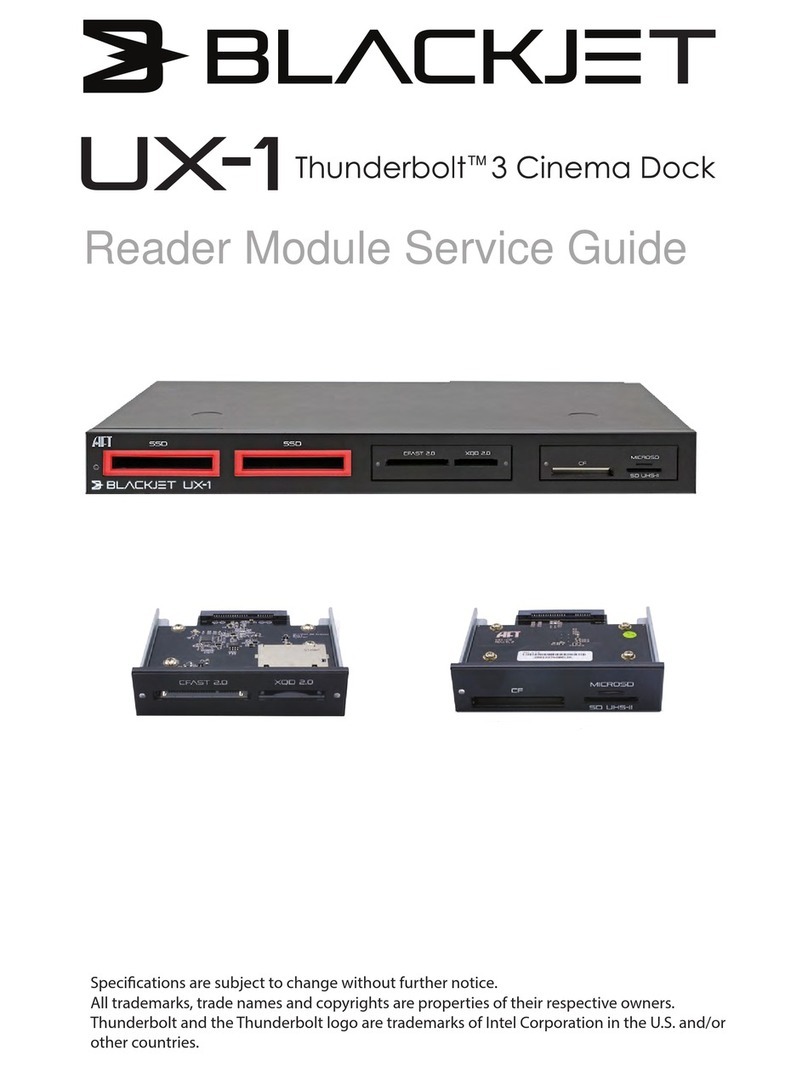
Blackjet
Blackjet UX-1 Service guide

Burkert
Burkert 2301 Series operating instructions
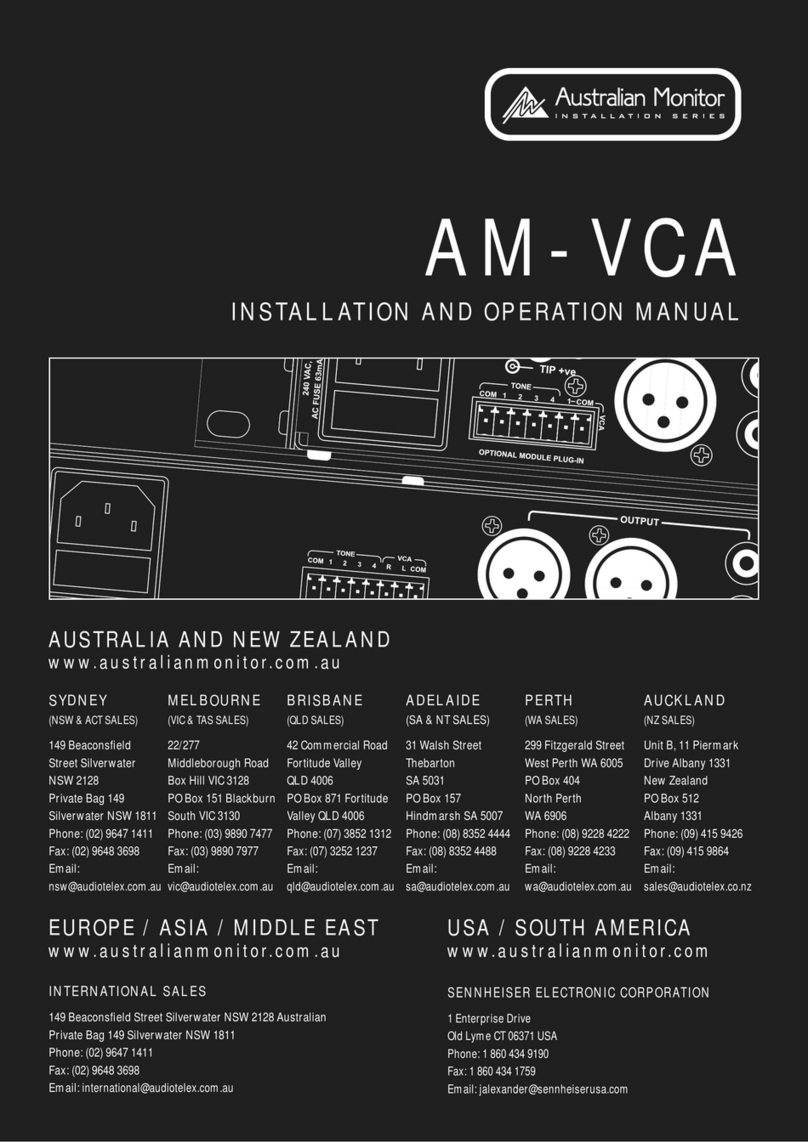
AUSTRALIAN MONITOR
AUSTRALIAN MONITOR AM-VCA Installation and operation manual

Texas Instruments
Texas Instruments TPS54383 user guide


